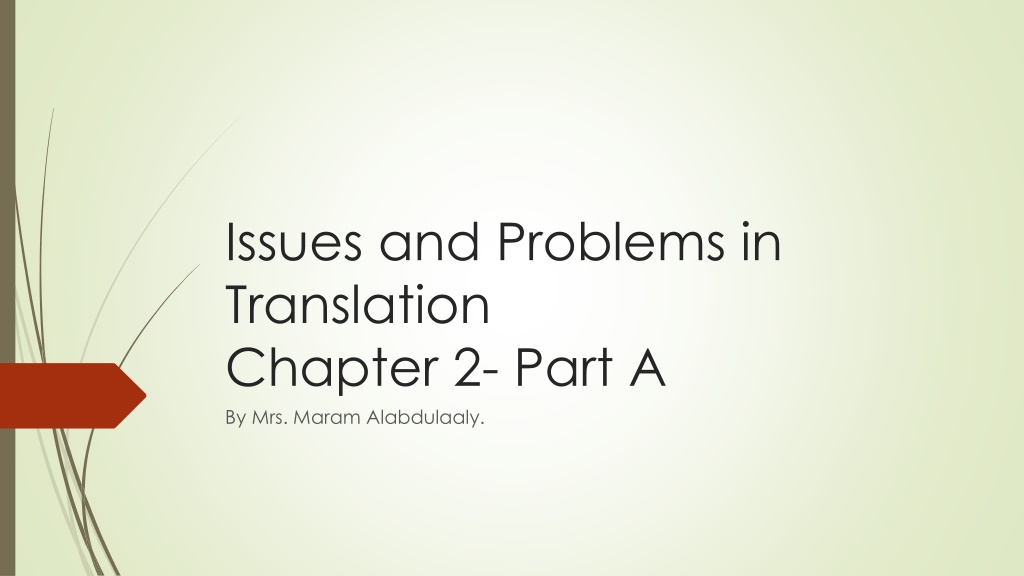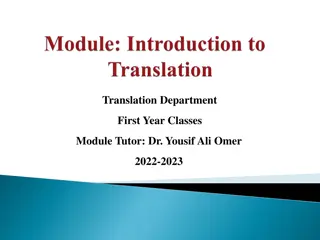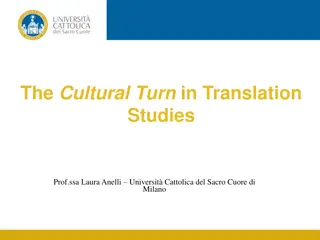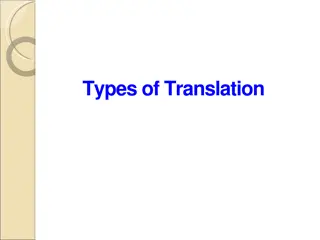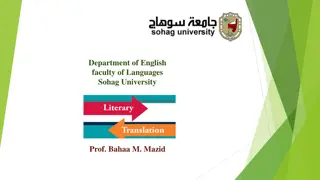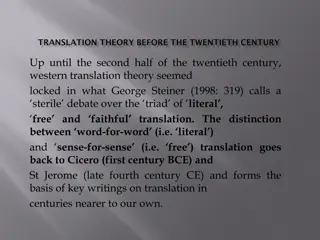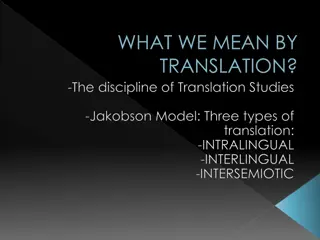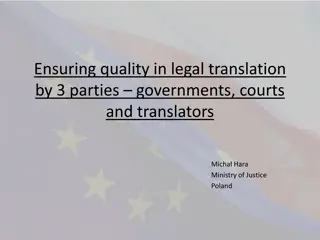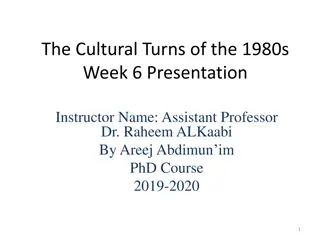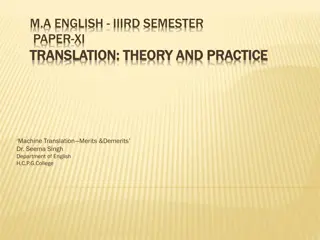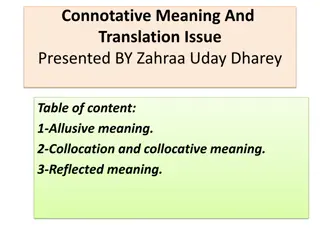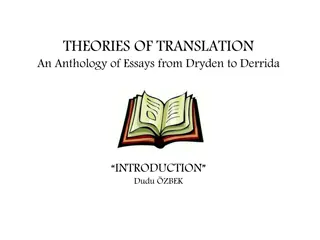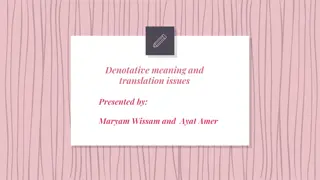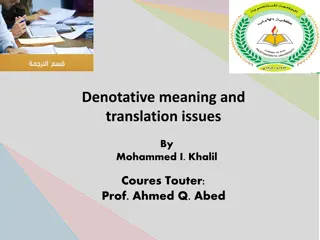Translation Challenges: Types of Meaning and Problems
In this chapter, Mrs. Maram Alabdulaaly explores types of meaning essential for translation success: Denotation, Connotation, and Contextual Meaning. The text delves into lexical, grammatical, stylistic, and pragmatic levels of translation problems, emphasizing the importance of understanding word nuances for accurate translation.
Download Presentation

Please find below an Image/Link to download the presentation.
The content on the website is provided AS IS for your information and personal use only. It may not be sold, licensed, or shared on other websites without obtaining consent from the author.If you encounter any issues during the download, it is possible that the publisher has removed the file from their server.
You are allowed to download the files provided on this website for personal or commercial use, subject to the condition that they are used lawfully. All files are the property of their respective owners.
The content on the website is provided AS IS for your information and personal use only. It may not be sold, licensed, or shared on other websites without obtaining consent from the author.
E N D
Presentation Transcript
Issues and Problems in Translation Chapter 2- Part A By Mrs. Maram Alabdulaaly.
Translating and recreating of texts: Types of Meaning: We have to consider the types of meaning to have a good translation. 1. Denotation 2. Connotation 3. Contextual Meaning
Types of meaning: a) Denotation: refers to the literal meaning of a word, that means, the definition you can get using your dictionary. For example, if you look up the word sweet in a dictionary, you will discover that one of its denotative meaning is a small piece of sweet food, usually made with sugar and/or chocolate and eaten between meals. a) Connotation: the associations that are connected to a certain word or the emotional suggestions related to that word. The connotative meanings of a word exist together with the denotative meanings. Arabic example: The word for example is a neutral whereas has positive connotations. Example: Politician Vs Statesperson. a) Contextual meaning: has to do with the recognition of the meaning of a word using the context where the word is. Bank: Example deal : I ll see you tomorrow, do we have a deal? Big deal!- Saudi Deal/ dealings witnessed a throwback in the stock exchange.
Translation Problems 1. Lexical Level. 2. Above Lexical Level. 3. Grammatical Level. 4. Stylistic Level. 5. Textual Level. 6. Pragmatic Level.
Lexical Level Lexical Level non- metaphorical vs. non- metaphorical meaning equivalent words or concepts: Hyponymy Synonymy Polysemy synonyms of emotive charge familiar alternative terms TL Equivalent doesn t cover all meaning absolute synonyms Lexical Gap Cultural Gap
Lexical Level Definition:The linguistic level that usually involves words. A word is the smallest unit of language that can be used by itself (Bolinger and Sears,1968:43) The greater number of translation problems for the students are lexical problems. (TRUE). Most of the students mistakes are their word-for-word translations of the SL texts, and ignorance of the TL equivalence.(TRUE)
1. Literal translation of meaning (metaphorical vs. non-metaphorical meaning): The central lexical problem for the students of translation is their direct, literal translation of almost all words. Words are used and understood in isolation(True or false)?False: Words are used and understood in texts and contexts There are two types of words: a) Grammatical words which have no meaning, but used for a specific grammatical function (such as the use of the verb do to make questions and negation in English, have to form the present perfect tense, etc); and b) lexical words which have meanings and make up language. What is the type of the following underlined words: She has lived in London. He has five cats. They have had dinner.
metaphorical vs. non-metaphorical meaning Direct translation of words is sometimes possible and acceptable, but not applicable to everything in language. Text and context are important in deciding the meaning of a word. English Arabic Translation strategy (direct) literal translation Notes The children broke the window. Rainy day No possibility for non- literal translation. Literal and non- literal translations \ Eexercise in P2 booklet. \ Enough is enough Non-literal translation Literal translation is not acceptable:
Meaning 2) Translation of synonymy: Word1 Word2 Synonymy is the sameness, or the similarity of meaning between two or more words. For example, big , large , and huge are synonyms. There are two types of synonyms: a) Absolute synonyms: words which are perfectly identical in meaning. This type is very rare in all languages (e.g. start and begin). Students think that all synonymous words are absolute synonyms. That is, all English words which are similar in meaning have the same identical meaning in Arabic.
2) Translation of synonymy: a) Near (or close) synonyms: words which are similar to one another in meaning. This type is commonplace in any language (e.g. angry and furious).
Meaning 2) Translation of synonymy: Word1 Word2 There are three major problems in translating synonyms: 1. synonyms of emotive charge 2. absolute synonyms 3. familiar alternative terms
2.1) synonyms of emotive charge: which reflects degree of feelings. He is angry He is annoyed He is bothered He is furious He is enraged All the adjectives above are synonyms for the meaning anger . They form together what is called a lexical field of anger. The field of anger can be divided into three main levels of meaning:
2.1) synonyms of emotive charge: which reflects degree of feelings. Very Angry He is furious lexical field of anger. He is enraged He is angry Little angry He is discomforted He is annoyed He is bothered He is worried He is nervous
synonyms of emotive charge: Solution Yes: Done Give Precise Equivalent Yes: Done State the level of the meaning No Give the general word of the field. No Give a lexical field of love and give an equivalent for the word infatuation .
2.2) translation of absolute synonyms The translation of absolute synonyms in a certain context only, because it is extremely difficult to differentiate among them as such in English as in Arabic translation: Example (1): start, begin, and commence In English, there is no clear difference in the meaning of these three words as verbs. Therefore, these words can be translated into Arabic by the equivalent " " and " " , although they seem artificial, are also acceptable depending on the context. . The words " "
2.3) translation of familiar alternative terms Definition: familiar alternatives are informal, local, and cordial nicknames(words or phrases used as substitutions for other formal ones). Examples from Arabic to English: The Secure City for Makkah Al-Mukarramah The Good City for Al-Madinah Al-Munawwarah The malicious disease for cancer The Chief for the Saudi Club, Al-Ittihad Example from English to Arabic: The red devils for The English Manchester United Club
2.4) translation of familiar alternative terms Problem: The difficulty to find them in general reference books like dictionaries. The difficulty to understand their local connotations and cultural implications for foreign students of different cultures (as in the red devils ). Solution: Search: search for the connotation of alternatives by using technology (the internet), by asking SL native speakers, watching specialized TV programs, etc. After knowing that, the translator should explain the connotation of an alternative between brackets \ parenthesis: [ ]. Example: VS For Alnasser football club, Vs for Alhelal football club.
2) Translation of synonymy: General criteria in translating synonyms: Looking at the word history Absolute synonyms/ familiar alternatives. Recognizing the author s style. Understanding the context The translator s preference The receptor s preference Page 6 Exercise.
Synonymy VS Polysemy Meaning 2 Meaning 1 Meaning Word1 Word2 Word Polysemy Synonymy Start, begin, commence Bank: (1of the river, 2of money).
3) Translation of Polysemy: Definition: Polysemy is a word that has more than one meaning. Bank: - - - Sound: - - - obligatory- pleased- eye- well-revenge- place : Solution: 1. knowing the type of the text. 2. looking at a good monolingual dictionary and understanding the different meanings of the word 3. understanding the context and finding the meaning of the word which is suitable to that context Page 6 Exercise.
4) Translation of Hyponymy: Definition: Languages tend to have general words (superordinates) but lack specific ones (hyponyms). Superordinate: Solution: 1. searching for the accurate equivalent in the TL; : 2. if could not, use the method of explanation. Example: Pig, swine, porker : :
5) The translation of non-equivalent words or concepts: Non-equivalence at the lexical level means that the target language has no direct equivalent for a word which occurs in the text. What are the reasons for non-equivalence at word level? Lexical Gap Cultural Gap The TL equivalent does not cover all the semantic meaning of the SL word.
5) The translation of non-equivalent words or concepts: Lexical Gap:it means that the source text word\ concept is not lexicalized in TL;the target language has no direct equivalent for the word\ concept which occurs in the text. a) slum: - Kilo: - Film: : sultan : tarrif - b)Cultural gap between the cultures of the SL and TL: culture-specific words and concepts (Religious belief, a social custom, or a type of food and tools): - - - - - - C) The TL equivalent does not cover all the semantic meaning of the SL word. charity alms Zakat Geology
5) The translation of non-equivalent words or concepts: Solution: Translation by a more general word (superordinate): Porker= The hyponyms (a more general word). in Arabic could be translated into English as a superordinate like uncle \ Translation using the method of naturalization: Equivalents for religious formulas like can be found in English but they will seem unnatural. Therefore is most naturally rendered as (I hope). Translation by cultural substitution: This means substituting the entire setting of the ST, resulting in the entire TT being rewritten in the target culture setting. Romeo and Juliet Translation using transcription or transcription plus explanation Imam Sheikh Intifada
5) The translation of non-equivalent words or concepts: Solution: Translation by paraphrasing: Paraphrase is based on explanations, additions and changes in word order. Example: He is a ship without compass Translation by omission: )...( Two days ago, the American President, Donald Trump, confirmed ( ) The word was omitted in the translation because the information conveyed is not important and adding it would unnecessarily complicate the structure of the TT (two day ago in the evening). Translation by creating new words (last option). Example: Transliteration= A term coined by from the words and
Lexical Level Lexical Level non- metaphorical vs. non- metaphorical meaning equivalent words or concepts: Hyponymy Synonymy Polysemy synonyms of emotive charge familiar alternative terms TL Equivalent doesn t cover all meaning absolute synonyms Lexical Gap Cultural Gap
Above Lexical Level Above Lexical Level Phrasal Verbs Collocations Idioms Proverbs
1) Collocations Definition: Collocations refer to the recurrent or habitual combinations of words that co-occur more often than they normally would be based on chance. This habitual association or lexical patterning is not normally governed by any specific rules; they are just the result of many years of habitual use by the native speakers of the language statements about collocations, when judging them, are expressed in terms of typicality: in terms of what is typical or untypical rather than what is admissible or inadmissible. Examples: Strong wind and heavy rain would not be normal to say heavy wind or strong rain. P8 and 9 for examples.
1) Collocations Collocations and translation: The best way to deal with collocations is to look at the main element in a collocation (the noun in an adjective+noun combination or the subject or object of a verb). This element is usually referred to as the "core word" and the word which combines with it is the "collocate". Look up the core word in a dictionary of collocations or an English-English dictionary. Remember that a SL collocation should be translated by a TL collocation. Exercise Page 9.
2) Idioms Definition: An idiom is an expression whose overall meaning cannot be determined by the meanings of the separate words, but refers instead to a figurative meaning that is known only through common use. The problem with idioms is that they don't usually cross language boundaries. Sometimes idioms can be translated into other languages if they happen to express common human experiences. But in some cases, when an idiom is translated into another language, the meaning of the idiom is changed or does not make any sense.
2) Idioms Idioms and translation: A SL idioms should be translated by a TL idiom. From English to Arabic: to consult a dictionary of idioms, to check the meaning of the idiom. A) Examples of idioms that can be translated literally into Arabic because they express common life experiences: 1) be all ears (listening eagerly and carefully): 2) an act of God (an occurrence for which no human is responsible):
2) Idioms Idioms and translation: A SL idioms should be translated by a TL idiom. From Arabic to English: Translating idioms from Arabic into English is always more challenging than translating them from English into Arabic. Why? we don t have Arabic-English dictionaries of idioms that provide equivalent Arabic idioms for the English ones. Solution: an English thesaurus can be of great help in this case. What a translator has to do is to think of an individual Arabic word that reflects the meaning of the Arabic idiom and find its English equivalent. The next step is to check a good thesaurus for the synonyms of this word. Usually good thesauruses include words, phrasal verbs, slang words, phrases that have the same meaning of the head word.
2) Idioms Idioms and translation: Example of Arabic idiom translation: . rarely. = = Thesaurus entry of rarely: Rarely adv. seldom, infrequently, on rare occasions, hardly (ever), scarcely (ever), almost never, Colloq once in a blue moon: He rarely attends formal dinners at his club.
2) Idioms Idioms and translation: If a translator failed in finding an accurate equivalent of a SL idiom, s\he can use one of the following methods: a) Transcription and explanation (as a footnote) b) Paraphrasing. c) Giving a TL equivalent which has the same function (but not necessarily meaning) of the SL idiom.
3) Phrasal Verbs: Definition: Phrasal verbs consist of a simple verb and one or two particles, where the meaning of the compound is often different from the meaning of the individual parts. The students face a big problem at translating phrasal verbs from English into Arabic because they are misleading and confused with prepositional verbs (v+prep.) which are not idiomatic. Example: Put on Please, put the book on the table: Please, put your coat on: and not
3) Phrasal Verbs: Phrasal verbs and translation: students should memorize the common English phrasal verbs and their Arabic equivalents. Also, s\he is advised to use a specialized dictionary when translating. There are specialized dictionaries that deal with phrasal verbs. Sometimes, dictionaries of idioms include phrasal verbs, considering that phrasal verbs have idiomatic meanings.
4) Proverbs: Definition: proverbs are special, fixed and unchanged phrases which have special, fixed and unchanged meanings. The equivalent of a proverb should be a proverb. Example: like father like son : ) ( All that glitters is not gold: Proverbs and translation: students should consult a good dictionary or consult a specialist or a native speaker of the SL or the TL.
